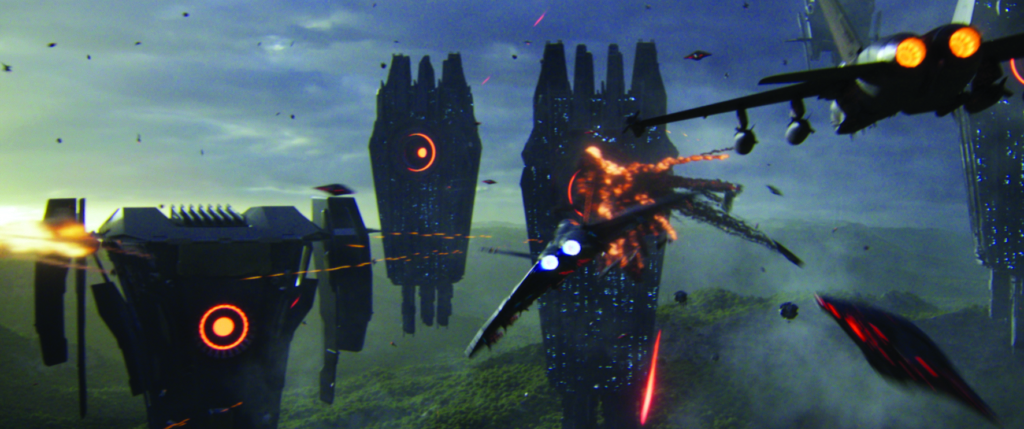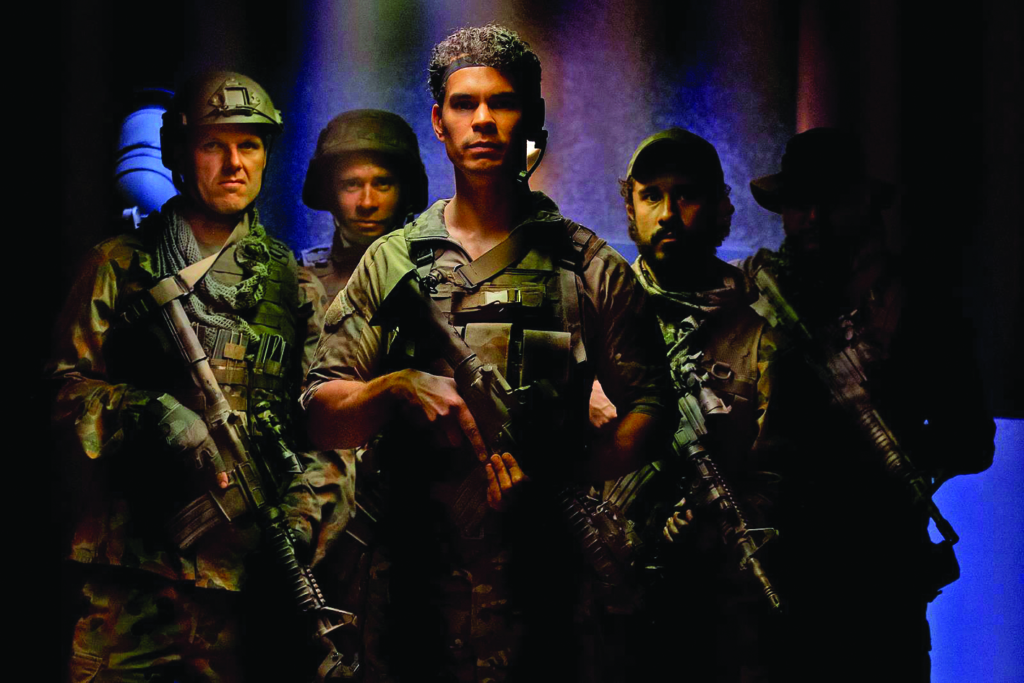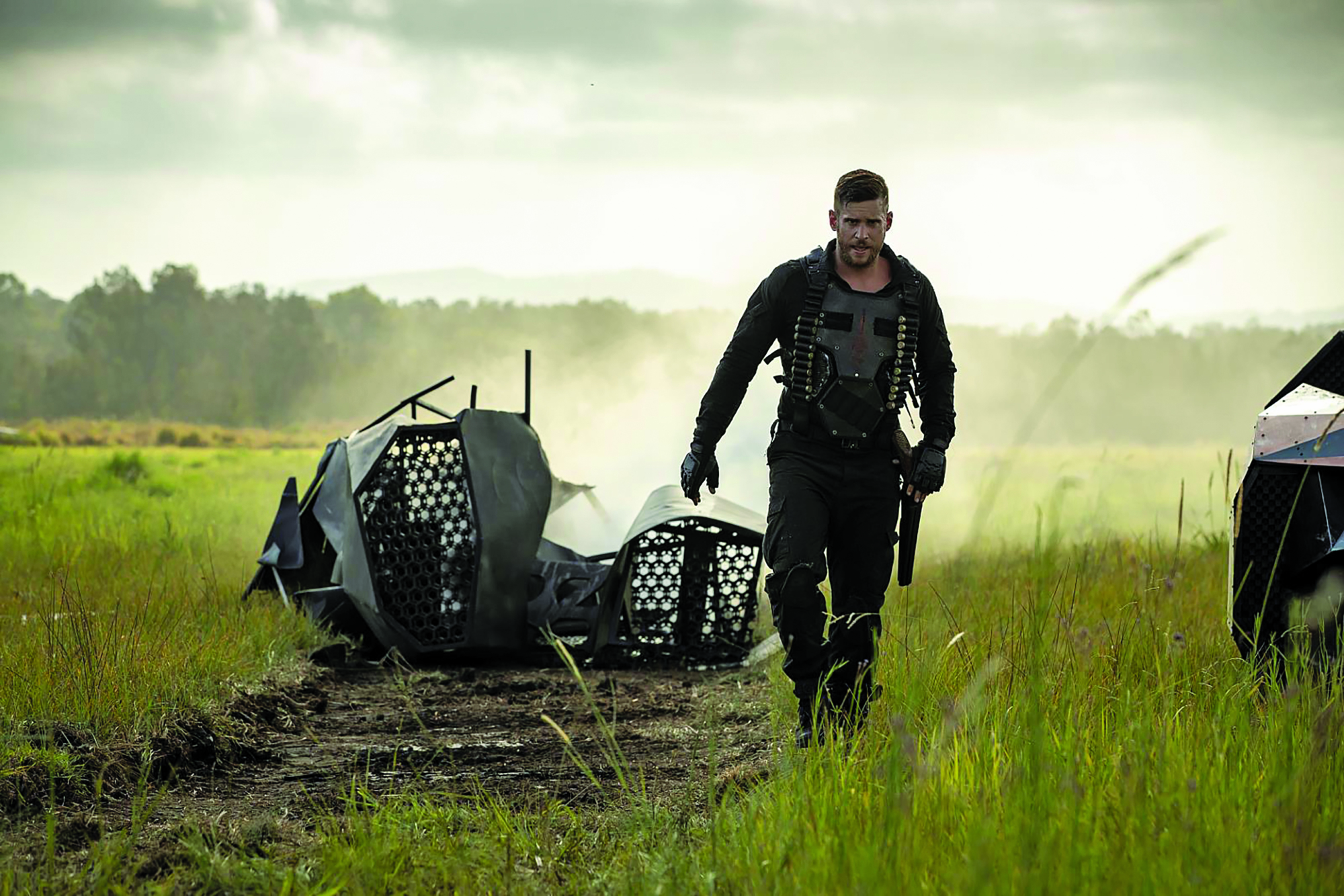No-one could have predicted that the tumultuous year that was 2020 would lead to Australia becoming a major hub of Hollywood production. With the US in turmoil due to the effects of the COVID-19 pandemic, the major studios have looked further afield to safer pastures. The result? Australia’s film studios have never been busier. Tom Hanks is headlining Baz Luhrmann’s Elvis Presley biopic on the Gold Coast;[1]See Amy Price, ‘“Anything with Four Walls Is a Film Set”: The Mega Stars Lured by QLD’s $414m Movie Boom’, The Courier Mail, 5 March 2021, <https://www.couriermail.com.au/lifestyle/qweekend/anything-with-four-walls-is-a-film-set-the-mega-stars-lured-by-qlds-414m-movie-boom/news-story/192d1c591b43b9a8c5b42b47affb5f6c>, accessed 12 March 2021. Ron Howard is in Queensland filming Thirteen Lives about the 2018 Thai cave rescue;[2]See Mike Fleming Jr, ‘Viggo Mortensen, Colin Farrell, Joel Edgerton Head Ensemble of Ron Howard–directed MGM Thai Cave Rescue Pic Thirteen Lives’, Deadline, 11 March 2021,<https://deadline.com/2021/03/viggo-mortensen-colin-farrell-joel-edgerton-ron-howard-thai-cave-rescue-movie-mgm-thirteen-lives-bron-imagine-1234712218> Liam Neeson has been shooting up the streets of Melbourne in Mark Williams’ Blacklight;[3]See Karl Quinn, ‘Behind the Scenes of Liam Neeson’s New Action Movie Filming in Melbourne’, The Sydney Morning Herald, 4 December 2020, <https://www.smh.com.au/culture/movies/behind-the-scenes-of-liam-neeson-s-new-action-movie-filming-in-melbourne-20201204-p56kq1.html>, accessed 12 March 2021. and our very own Chris Hemsworth has been flexing his considerable muscle, together with Natalie Portman, at Sydney’s Fox Studios for Taika Waititi’s Thor: Love And Thunder.[4]See Lexie Cartwright, ‘Chris Hemsworth, Chris Pratt Seen Filming Thor: Love and Thunder in Sydney’, News.com.au, 2 February 2021,<https://www.news.com.au/entertainment/movies/upcoming-movies/chris-hemsworth-chris-pratt-seen-filming-thor-love-and-thunder-in-sydney/news-story/14d37ddca49b5fbfc3474f5795255907>, accessed 12 March 2021. Australia has become the new home of the blockbuster – or has it?
While this headlining Hollywood talent may appear to be keeping the local film industry afloat, Australian-made blockbusters – or even attempts to encroach on that space – remain thin on the ground. An exception is alien-invasion action film Occupation: Rainfall (Luke Sparke, 2020), a work with genuine blockbuster credentials that, despite its relatively small budget, can stand proudly next to its overseas counterparts.

But what constitutes a blockbuster these days, and why are Australian audiences so reticent to queue around the block on opening weekend for a film that was made in their own backyard? Since the 1970s, when Jaws (Steven Spielberg, 1975) and Star Wars (George Lucas, 1977) changed the way audiences watched movies, Australian filmmakers have found themselves in constant competition with the next big thing from the States. As US budgets got bigger and on-screen spectacle became more spectacular, antipodean cinema fought back with the salacious, low-rent, crowd-pleasing thrills and explosive gore of the Ozploitation era,[5]For further discussion of this, see Deborah Thomas, ‘Tarantino’s Two Thumbs Up: Ozploitation and the Reframing of the Aussie Genre Film’, Metro, no. 161, 2009, pp. 90–5. but that fad could only be pursued so far. It was no surprise, then, when the more family-friendly charms of Crocodile Dundee (Peter Faiman, 1986) gave Australian cinema its first major international hit, with Mick Dundee (Paul Hogan) proving a huge draw at home and overseas.
That film proved a major influence on Sparke’s debut, outback creature feature Red Billabong (2016), which attempted to fuse Dundee’s ocker charm with the classic monster-movie tropes of horror films from the time of the director’s childhood like Razorback (Russell Mulcahy, 1984). Even at this stage of his career, with a modest budget at his disposal, Sparke was already aiming high with his CGI creation. Red Billabong also signposted the stateside influences that would colour his two sci-fi actioners to come, such as – in the director’s own words – ‘Raiders of the Lost Ark [Spielberg, 1981], Star Wars [Lucas, 1977], Aliens [James Cameron, 1986], Die Hard [John McTiernan, 1988], all that 1980s stuff’.[6]Luke Sparke, quoted in David Michael Brown, ‘Hits from the ’Bong’, Empire (Australasia), no. 185, August 2016, p. 23.
The film, consisting of 1600 special-effects shots, provides enough eye-scorching destruction to keep the most avid multiplex patron happy. But hitting that audience is another matter.
Occupation (2018), Sparke’s precursor to Occupation: Rainfall, was shot and set in Australia but is steeped in small-town Americana. Beginning like an antipodean Friday Night Lights (Peter Berg, 2004), the film soon follows tried-and-tested territory in a storyline that echoes that other Red Dawn (John Milius, 1984)–inspired Aussie action flick, Tomorrow, When the War Began (Stuart Beattie, 2010). Sparke, however, takes a very different approach to Beattie’s adaptation of the John Marsden teen-lit classic: rather than depicting invasion by a hostile nation-state, Occupation looks to the stars for its adversary, with its small band of survivors fighting against a malevolent alien force.[7]See Oliver Pfeiffer, ‘Landing Success: Luke Sparke and Carly and Carmel Imrie on Occupation’, Metro, no. 198, 2018, pp. 28–31. Occupation: Rainfall is situated in the brutal aftermath of that tale, taking place two years after humanity’s perilous close encounter. With Earth on the brink of collapse, the balance between humankind and its new extraterrestrial neighbours is on a knife’s edge: factions on both sides want peace, but they stand against the opinions of the heavily armed majority. Rainfall once again features Dan Ewing, Trystan Go and veteran Kiwi performer Temuera Morrison, while Jet Tranter takes on the role previously played by Hong Kong–born actress Stephany Jacobsen as revolutionary Amelia. Sparke has also added a comedic double team in Ken Jeong and Jason Isaacs, with the latter voicing alien Steve.

In reality, however, the cast are mere cyphers – pawns in Sparke’s epic story. Whereas the first film focused on a small group of combatants taking on the alien threat, the sequel is all about the spectacle. It’s in the moments when the film strives to be a crowd-pleasing blockbuster that its ambitious director excels. As Sparke explains, when he was writing Occupation: Rainfall, he refused to allow money to be a factor:
With Rainfall, I said from the get go that I’m going to write what I think it needs, no matter how big it is and then we’ll sit down and figure it out. And what I wrote was huge. A sprawling film with so many action sequences, large locations and set pieces. Then once we started working things out, I kept adding to the script, pulling other parts out, filling more screen time with as [many] interesting and world building scenes, shots or moments as I could. I’m happy to say that we’ve pulled off even more than was scripted.[8]Luke Sparke, quoted in Rike Wittkaemper, ‘Occupation: Rainfall Interview – Luke Sparke’, The FANdemonium Network, 3 November 2020, <https://fandemoniumnetwork.com/occupation-rainfall-interview-luke-sparke/>, accessed 12 March 2021.
Those set pieces are more than a match for Occupation: Rainfall’s cashed-up competition, even if they may not be quite as polished. Frenetic airborne dogfights play out at breakneck speed as fighter jets and alien craft strafe the sky with rockets and lasers; Sydney is destroyed as an immense alien task force hovers above Earth’s surface; everything that can explode does. Even the reluctant buddy movie playing out amid the mayhem – between stubborn, belligerent protagonist Matt (Ewing) and the defecting alien he has been forced to team up with, Gary (Lawrence Makoare) – is an impressive technical achievement. The sheer scale of the destruction on display is astounding when considering what the director had to work with. The film, put together over two years and consisting of 1600 special-effects shots,[9]Dov Kornits, ‘Luke Sparke Aims for the Stars’, FilmInk, 26 January 2021, <https://www.filmink.com.au/luke-sparke-aims-for-the-stars/>, accessed 26 January 2021. provides enough eye-scorching destruction to keep the most avid multiplex patron happy. But hitting that audience is another matter.
At the independent end of the scale, there has always been a stigma surrounding Australian films: specifically, that they are ‘dark and depressing’.[10]Karl Quinn, ‘Why Don’t We Watch Australian Films?’, The Sydney Morning Herald, 26 October 2014, <https://www.smh.com.au/entertainment/movies/why-wont-we-watch-australian-films
-20141024-11bhia.html>, accessed 15 March 2021. And while it’s true that films about drug addiction, domestic violence, our dark colonial past and mistreatment of Indigenous people may make for harrowing viewing, these are nonetheless important stories that need to be told. Blockbusters, on the other hand, are here for pure entertainment. When faced with the choice between a solitary Aussie flick and the host of big-name American features jostling for pole position on the marquee at any given point in time, the average Australian cinema-goer will cast an international vote. Inversely, around the world, Australian films are rarely audiences’ first port of call. Films that were smash hits here could not always guarantee the same success elsewhere: The Sapphires (Wayne Blair, 2012), The Dressmaker (Jocelyn Moorhouse, 2015) and The Water Diviner (Russell Crowe, 2014) all failed when they made the trip abroad.[11]See Luke Buckmaster, ‘Why Don’t We Watch More Australian Films?’, The Guardian, 15 March 2021, <https://www.theguardian.com/culture/australia-culture-blog/2013/jul/18/australian-film-bigger-audiences>; Tom Brueggemann, ‘Arthouse Audit: Queen of Katwe and The Dressmaker Start Slow in Multiple Theaters’, IndieWire, 25 September 2016, <https://www.indiewire.com/2016/09/weekend-box-office-queen-of-katwe-lupita-nyongo-the-dressmaker-kate-winslet-arthouse-audit-1201730427/>; and Karl Quinn, ‘Australian Film Has Had Its Biggest Year at the Box Office Ever. Why?’, The Sydney Morning Herald, 5 December 2015, <https://www.smh.com.au/entertainment/movies/australian-film-has-had-its-biggest-year-at-the-box-office-ever-why-20151204-glfut3.html>, all accessed 15 March 2021. A recent exception has been the horror-thriller genre: The Invisible Man (Leigh Whannell, 2020) recorded healthy returns domestically, but, following in the footsteps of Wolf Creek (Greg McLean, 2005),[12]See Charles Purcell, ‘Up the Creek’, The Sydney Morning Herald, 28 October 2005, <https://www.smh.com.au/entertainment/movies/up-the-creek-20051028-gdmbvx.html>, accessed 15 March 2021. made considerably more overseas.[13]See Karl Quinn, ‘Australian-made Thriller The Invisible Man Proves Surprise Global Hit’, The Sydney Morning Herald, 2 March 2020,<https://www.smh.com.au/culture/movies/australian-made-thriller-the-invisible-man-proves-surprise-global-hit-20200302-p5465r.html>, accessed 15 March 2021.

It’s not always as simple as genre films succeeding where arthouse ventures don’t, however. Even Mad Max: Fury Road (George Miller, 2015), the director’s fourth movie in the series and the first to star British actor Tom Hardy as the titular post-apocalyptic loner, did not perform as well as expected. Yes, the film was shot in Namibia with an international cast including Charlize Theron and Nicholas Hoult along with Hardy, but the spiralling costs of Miller’s astonishing vision ensured that, despite garnering six Oscars and gushing critical praise (Fury Road topped many ‘films of the year’ lists[14]See Scott Roxborough, ‘International Film Critics Vote Mad Max: Fury Road Year’s Best Film’, The Hollywood Reporter, 1 September 2015, <https://www.hollywoodreporter.com/news/international-film-critics-vote-mad-819271>, accessed 15 March 2021.), it barely recouped its costs.[15]See Scott Mendelson, ‘Box Office: Why a Mad Max: Fury Road Sequel Is a Risky Bet’, Forbes, 17 April 2018, <https://www.forbes.com/sites/scottmendelson/2018/04/17/box-office-a-sequel-to-mad-max-fury-road-is-a-huge-risk/?sh=37fd86085f65>, accessed 15 March 2021. In the list of the top-earning Australian films of all time at the domestic box office, it is still Crocodile Dundee that reigns supreme. The rest of the top ten is made up by sequel Crocodile Dundee II (John Cornell, 1988); various works by the omnipresent Luhrmann; more family-friendly fare like Happy Feet (Miller, 2006), Babe (Chris Noonan, 1995) and Peter Rabbit (Will Gluck, 2018);and Garth Davis’ devastating drama Lion (2016). Mad Max: Fury Road comes in eleventh, and is arguably the first work in the list with serious genre-blockbuster bona fides.[16]Screen Australia, ‘Top 100 Australian Feature Films of All Time’, February 2021, <https://www.screenaustralia.gov.au/fact-finders/cinema/australian-films/top-films-at-the-box-office>, accessed 15 March 2021.
That’s the interesting thing about the present situation in Australian cinemas. As smaller, often independent, local movies fill the void left by the oft-delayed likes of Black Widow (Cate Shortland), No Time to Die (Cary Joji Fukunaga) and Death on the Nile (Kenneth Branagh), they have been finding an audience. Robert Connolly’s The Dry (2020), starring Eric Bana and adapted from the Jane Harper novel of the same name, has earned around A$20 million; and the Naomi Watts–starring Penguin Bloom (Glendyn Ivin, 2020), again based on a much-loved tome, is standing at A$7 million at the time of writing. Even the stunning High Ground (Stephen Maxwell Johnson, 2020), which was not an obvious crowd-pleaser despite a cast featuring Simon Baker and Aussie legend Jack Thompson, has taken in the better part of A$3 million.[17]See David Tiley, ‘Box Office: Australians Hang In as Tentpoles Hoisted in Multiplexes’, ArtsHub, 9 March 2021, <https://www.artshub.com.au/news-article/news/film/david-tiley/box-office-australians-hang-in-as-tentpoles-hoisted-in-multiplexes-262059>, accessed 15 March 2021. Why, then, are the box-office results for Occupation: Rainfall much lower (at the time of writing, well under half-a-million Australian dollars[18]See ‘Occupation Rainfall (2021)’, The Numbers, <https://www.the-numbers.com/movie/Occupation-Rainfall-(Australia)#tab=summary>, accessed 15 March 2021.)? For a film designed for the multiplexes, the returns so far on a not-insignificant A$25 million[19]See Garry Maddox, ‘“I’m Going to Write Something Big”: How a Little-seen Sci-fi Movie Spawned a $25m Sequel’, The Sydney Morning Herald, 24 January 2021, <https://www.smh.com.au/culture/movies/i-m-going-to-write-something-big-how-a-little-seen-sci-fi-movie-spawned-a-25m-sequel-20210120-p56vnn.html>, accessed 15 March 2021. have not been as high as expected considering the situation we are now living in. Is it the cast? Is it cultural cringe? Or is it as simple as there being something bigger (but not necessarily better) on the other screen?
Seeking out international actors is a tried-and-tested method to grab an audience’s attention, and can certainly help a low-key project catch interest (as Sparke was presumably hoping to do by stunt casting Jeong and Isaacs). In the 1980s, producers like Antony I Ginnane were lambasted for setting Australian films in the States and filling their casts with overseas performers in order to maximise box-office returns – a case in point being Harlequin (Simon Wincer, 1980), which stars British actors Robert Powell and David Hemmings.[20]See Richard Kuipers, ‘Curator’s Notes’, ‘Harlequin (1980)’, Australian Screen, <https://aso.gov.au/titles/features/harlequin/notes/>, accessed 15 March 2021. What that approach did in the long term, arguably, was to help turn Australian audiences away from mainstream Australian films.
That’s always been a major problem for the Australian film industry. If you venture into blockbuster-land, somewhere very few homegrown filmmakers dare to tread, how do you compete with the American marquee movies that boast Hollywood star power and bottomless wallets without losing the cultural identity that is so important to national cinema? It’s a question that Sparke asked himself with Occupation: Rainfall, and his answer is simple: ‘We can make something for the world stage here, all in Australia [and] by Australian people.’[21]Sparke, quoted in Kornits, op. cit. The challenge is to get audiences to think the same.
http://www.occupationthemovie.com/
Endnotes
| 1 | See Amy Price, ‘“Anything with Four Walls Is a Film Set”: The Mega Stars Lured by QLD’s $414m Movie Boom’, The Courier Mail, 5 March 2021, <https://www.couriermail.com.au/lifestyle/qweekend/anything-with-four-walls-is-a-film-set-the-mega-stars-lured-by-qlds-414m-movie-boom/news-story/192d1c591b43b9a8c5b42b47affb5f6c>, accessed 12 March 2021. |
|---|---|
| 2 | See Mike Fleming Jr, ‘Viggo Mortensen, Colin Farrell, Joel Edgerton Head Ensemble of Ron Howard–directed MGM Thai Cave Rescue Pic Thirteen Lives’, Deadline, 11 March 2021,<https://deadline.com/2021/03/viggo-mortensen-colin-farrell-joel-edgerton-ron-howard-thai-cave-rescue-movie-mgm-thirteen-lives-bron-imagine-1234712218> |
| 3 | See Karl Quinn, ‘Behind the Scenes of Liam Neeson’s New Action Movie Filming in Melbourne’, The Sydney Morning Herald, 4 December 2020, <https://www.smh.com.au/culture/movies/behind-the-scenes-of-liam-neeson-s-new-action-movie-filming-in-melbourne-20201204-p56kq1.html>, accessed 12 March 2021. |
| 4 | See Lexie Cartwright, ‘Chris Hemsworth, Chris Pratt Seen Filming Thor: Love and Thunder in Sydney’, News.com.au, 2 February 2021,<https://www.news.com.au/entertainment/movies/upcoming-movies/chris-hemsworth-chris-pratt-seen-filming-thor-love-and-thunder-in-sydney/news-story/14d37ddca49b5fbfc3474f5795255907>, accessed 12 March 2021. |
| 5 | For further discussion of this, see Deborah Thomas, ‘Tarantino’s Two Thumbs Up: Ozploitation and the Reframing of the Aussie Genre Film’, Metro, no. 161, 2009, pp. 90–5. |
| 6 | Luke Sparke, quoted in David Michael Brown, ‘Hits from the ’Bong’, Empire (Australasia), no. 185, August 2016, p. 23. |
| 7 | See Oliver Pfeiffer, ‘Landing Success: Luke Sparke and Carly and Carmel Imrie on Occupation’, Metro, no. 198, 2018, pp. 28–31. |
| 8 | Luke Sparke, quoted in Rike Wittkaemper, ‘Occupation: Rainfall Interview – Luke Sparke’, The FANdemonium Network, 3 November 2020, <https://fandemoniumnetwork.com/occupation-rainfall-interview-luke-sparke/>, accessed 12 March 2021. |
| 9 | Dov Kornits, ‘Luke Sparke Aims for the Stars’, FilmInk, 26 January 2021, <https://www.filmink.com.au/luke-sparke-aims-for-the-stars/>, accessed 26 January 2021. |
| 10 | Karl Quinn, ‘Why Don’t We Watch Australian Films?’, The Sydney Morning Herald, 26 October 2014, <https://www.smh.com.au/entertainment/movies/why-wont-we-watch-australian-films -20141024-11bhia.html>, accessed 15 March 2021. |
| 11 | See Luke Buckmaster, ‘Why Don’t We Watch More Australian Films?’, The Guardian, 15 March 2021, <https://www.theguardian.com/culture/australia-culture-blog/2013/jul/18/australian-film-bigger-audiences>; Tom Brueggemann, ‘Arthouse Audit: Queen of Katwe and The Dressmaker Start Slow in Multiple Theaters’, IndieWire, 25 September 2016, <https://www.indiewire.com/2016/09/weekend-box-office-queen-of-katwe-lupita-nyongo-the-dressmaker-kate-winslet-arthouse-audit-1201730427/>; and Karl Quinn, ‘Australian Film Has Had Its Biggest Year at the Box Office Ever. Why?’, The Sydney Morning Herald, 5 December 2015, <https://www.smh.com.au/entertainment/movies/australian-film-has-had-its-biggest-year-at-the-box-office-ever-why-20151204-glfut3.html>, all accessed 15 March 2021. |
| 12 | See Charles Purcell, ‘Up the Creek’, The Sydney Morning Herald, 28 October 2005, <https://www.smh.com.au/entertainment/movies/up-the-creek-20051028-gdmbvx.html>, accessed 15 March 2021. |
| 13 | See Karl Quinn, ‘Australian-made Thriller The Invisible Man Proves Surprise Global Hit’, The Sydney Morning Herald, 2 March 2020,<https://www.smh.com.au/culture/movies/australian-made-thriller-the-invisible-man-proves-surprise-global-hit-20200302-p5465r.html>, accessed 15 March 2021. |
| 14 | See Scott Roxborough, ‘International Film Critics Vote Mad Max: Fury Road Year’s Best Film’, The Hollywood Reporter, 1 September 2015, <https://www.hollywoodreporter.com/news/international-film-critics-vote-mad-819271>, accessed 15 March 2021. |
| 15 | See Scott Mendelson, ‘Box Office: Why a Mad Max: Fury Road Sequel Is a Risky Bet’, Forbes, 17 April 2018, <https://www.forbes.com/sites/scottmendelson/2018/04/17/box-office-a-sequel-to-mad-max-fury-road-is-a-huge-risk/?sh=37fd86085f65>, accessed 15 March 2021. |
| 16 | Screen Australia, ‘Top 100 Australian Feature Films of All Time’, February 2021, <https://www.screenaustralia.gov.au/fact-finders/cinema/australian-films/top-films-at-the-box-office>, accessed 15 March 2021. |
| 17 | See David Tiley, ‘Box Office: Australians Hang In as Tentpoles Hoisted in Multiplexes’, ArtsHub, 9 March 2021, <https://www.artshub.com.au/news-article/news/film/david-tiley/box-office-australians-hang-in-as-tentpoles-hoisted-in-multiplexes-262059>, accessed 15 March 2021. |
| 18 | See ‘Occupation Rainfall (2021)’, The Numbers, <https://www.the-numbers.com/movie/Occupation-Rainfall-(Australia)#tab=summary>, accessed 15 March 2021. |
| 19 | See Garry Maddox, ‘“I’m Going to Write Something Big”: How a Little-seen Sci-fi Movie Spawned a $25m Sequel’, The Sydney Morning Herald, 24 January 2021, <https://www.smh.com.au/culture/movies/i-m-going-to-write-something-big-how-a-little-seen-sci-fi-movie-spawned-a-25m-sequel-20210120-p56vnn.html>, accessed 15 March 2021. |
| 20 | See Richard Kuipers, ‘Curator’s Notes’, ‘Harlequin (1980)’, Australian Screen, <https://aso.gov.au/titles/features/harlequin/notes/>, accessed 15 March 2021. |
| 21 | Sparke, quoted in Kornits, op. cit. |





